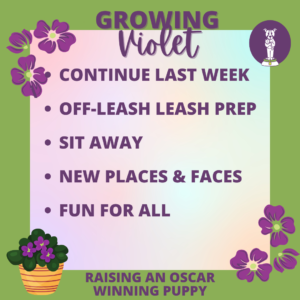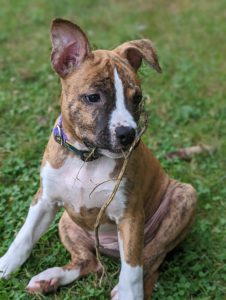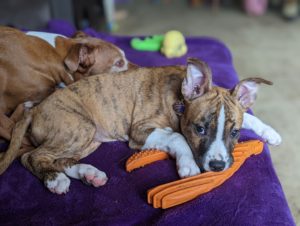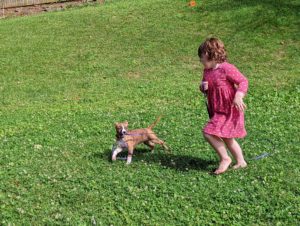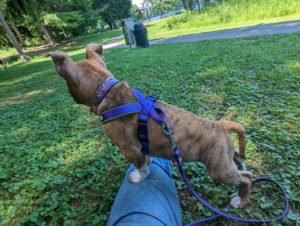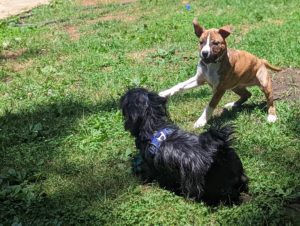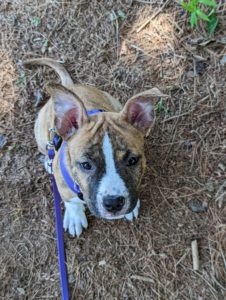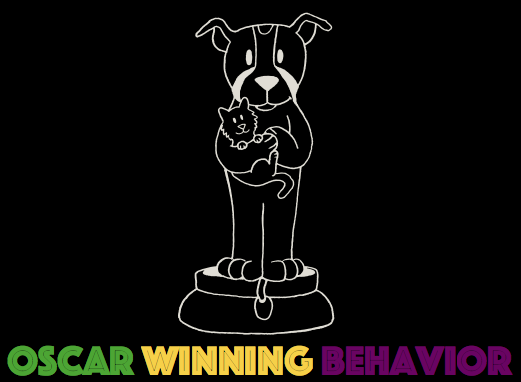So now you’re a full week into puppy parenting. You’re probably finding yourself deep in the throes of “My Last Dog-Itis” – your last dog wasn’t so bitey. Your last dog never peed halfway to the back door. Your last dog had to walk through knee deep snow, uphill both ways…. wait, that’s something else.
But you get the point. We remember our last dogs as they were as adults that had time to settle into our households. They knew our little quirks, for the most part; they knew just how to snuggle on the couch, they knew to hold it until you had the leash on, and they were generally perfect. But…. they were probably puppies, too. They were just smart enough to be puppies years ago, and not today, when you’re tired, and stressed, and there’s a pandemic, and life is *gestures at everything*
It’s okay. You’ll make it through this. Step by step, a little at a time, you can do it. Try to remember your new puppy is just that – new. You may have had dogs before, but they’ve never had a family before! Keep expanding their skills and experiences a little bit at a time. This week, you’re going to keep doing everything you did last week. Keep crating puppy every time they can’t be closely monitored, and when they start to get too rambunctious or mouthy, and taking them outside immediately after releasing them, and at least as often as they are months old (at ten weeks old, we’re taking Violet out every two and a half hours or so). Keep making all of their experiences as positive as you can. And keep slowly getting used to each other!
This week, we did the same – Violet got tucked away when she would get too rowdy or toothy, and she’s even starting to learn this means she needs a nap! I caught her trying to put herself to bed … and of course because it meant she would have been unsupervised, I brought her back out, only to have an over-tired baby start chewing on me…. sigh. Trust your dog, right? So off to her pen she went, and sweet dreams she soon had.
We continued with family introductions. Yes, she’s been with us two weeks, but we’re not going to leave her alone with the adult dogs until she’s much closer to their size – if ever. Here’s the thing: your dogs *never* need to be left unsupervised together. If you end up being comfortable with that arrangement, that’s great. But chances are when you aren’t there, they’re asleep most of the time. If they aren’t, you don’t want them to get into a scuffle over a bit of kibble that bounced under the couch ages ago, or a toy you didn’t pick up. Violet is still learning whose toys are whose, and there’s no need to rush that. So she can be out with the big dogs while we’re with her, and she goes away when we aren’t. This has the added but very important benefit of giving the adult dogs a breather from her energy and teeth. They didn’t ask to be full-time baby-sitters, they would like to remind you.
Violet also had two little field trips, one to a friend’s house where she wandered around with those family dogs, and another to a local park, where she and I sat on a bank and people-watched. Whenever anything sparked her attention, Violet got a treat! This starts the idea that these intriguing things in the world are good things, because they make treats happen, and beyond that, it’s good to be next to me when they happen, because that’s where the treats are! This field trip gave her good practice wearing her harness, seeing other dogs and wildlife, and meeting new people, all in fun ways.
We had a friend come over with their small dog – a little terrier about Violet’s size. Each new introduction we’ve had with her, we’ve tried to make as positive as possible. Best case scenario is actually if the dogs *don’t* spend the whole time playing – we want Violet to learn that other dogs are pleasant, but not a constant stream of excitement. I’m trying to be selective about what dogs she meets, and keeping a close eye on how they correct her. Yes, adult dogs *are* allowed to correct her when she breaks a doggy rule. They’re allowed to tell her she can’t take toys out of their mouths, or that her bites are too hard, or that they don’t want her to sit on their heads. But the punishment must fit the crime. If I see an adult giving any sort of correction – stiffening up, lifting a lip, growling or worse – I’ll help them out and call Violet over to me. These corrections should be small, and start off very, very mild (you probably wouldn’t even notice them) and get gradually more intense if needed, but stop immediately when puppy stops… puppying. If you’re at all concerned about this stage, get a trainer to help you with body language/communication issues (Oscar Winning Behavior can help – get video and we can do an online session to talk about things!). If things get too tense, we immediately separate the dogs, and give Violet (all of them, really) lots of snuggles and treats, so that the last thing she remembers about the situation is that it ended well!
We found a few activities Violet enjoys – specifically tug. We’ll keep encouraging this game and making it fun, so we can use it as a reinforcer as we start to teach her other things! For now, we’re doing tiny retrieves (of about five feet or so) and rewarding with a short game of tug. These also help improve our relationship and give us ways to tire her out productively! Our sit practices have tugs intermixed with the treats, and our leash manners can have tug as an occasional reward as well. It’s great to have multiple options for reinforcers! As for leash manners, we continued occasional potty breaks on leash, but most of our on-leash work was actually off leash. I’d take a little stroll around our yard (this would also work inside the house) and whenever Violet catches up to me – which is often, because that’s what puppies do – I’d give her a treat. More specifically, I’d give her a treat at my left ankle. Before long, she would trot around the yard with me, keeping her little self pretty close to my left ankle. No leash needed; she learns to keep an eye on me and stay close. Getting good at this off-leash means when we add the leash, things will be much easier!
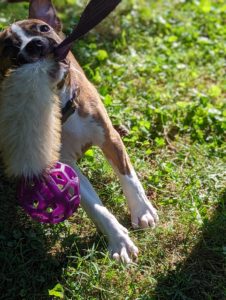
She also started learning “sit” – it’s not perfect by any means, but hey, neither am I. To do this, we took a treat right by her nose, and slowly dragged it between her eyes towards her tail. As her nose went up, her butt went down – voila! We repeated this with the treat two times, then faked a treat, holding our hand in the exact same way, but without food in our hand. This way the food doesn’t become part of the cue. Once we’ve done this maybe five times, we start saying sit when we’re 100% positive she’s going to put her butt on the ground. After about five more times (your mileage may vary depending on distractions around you) we can say the word and her butt goes down! Now we just practice it in as many comfortable situations as possible (knowing that if she’s not comfortable or is overly distracted, it won’t happen) and reward her heavily! Here’s video of our tiny friend Morris doing the same thing.
And that’s week two down! This just might be manageable after all!
Did you miss week one? Get started here
Need Oscar Winning help? Get started by filling out this form.
